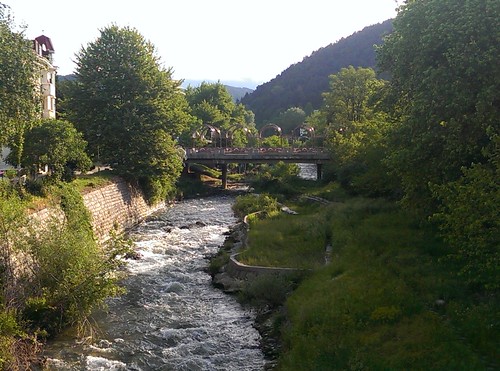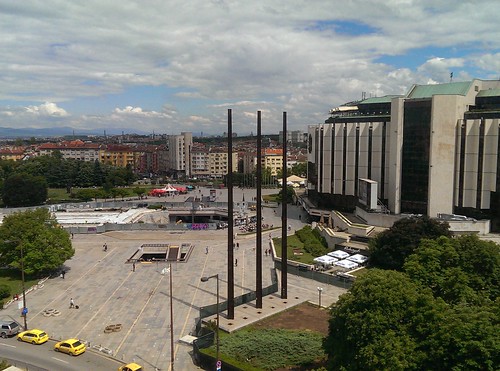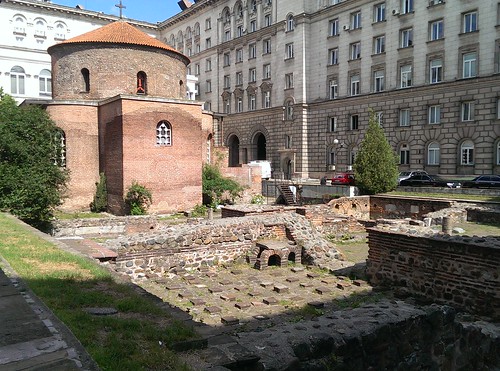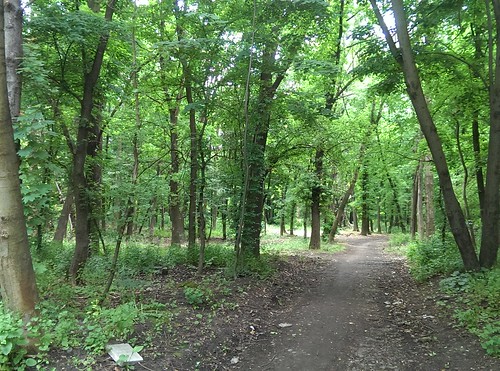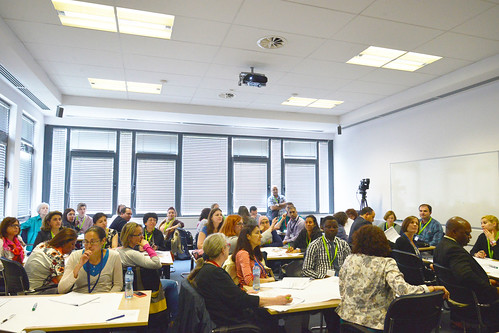Monday night – 10:26pm
SO that flat tire in the middle of I-205 really sucked. Having ODOT incident response pull up right behind us and change the tire did NOT suck at all. How lucky am I? I guess that travelling mercies are a real thing. Here is my donut. DO NOT MOCK IT. I think it’s cute. I was, of course, all prepared to change that f&*%@r myself should the need arise.
 But the ride with Dan (we all know not to call him Discovery Dan, right? RIGHT?) was really good. A great chance to get to know him and he gets my official cool dude stamp of approval.
But the ride with Dan (we all know not to call him Discovery Dan, right? RIGHT?) was really good. A great chance to get to know him and he gets my official cool dude stamp of approval.
I finally practiced my presentation tonight, and guess what! It’s 10 minutes too short, so tomorrow I’m going to attempt something pretty dangerous. As long as there is a stable internet connection, I”m going to try to do some live edits in front of the studio audience. I promise not to break anything. Much. Please wish me luck. I’m really nervous. The flat tire just means all the bad luck is out of the way.
In other news, the motor pool guy (I think his name was Justin) gave me a disposable camera and told me to take 5 photos with it on this trip. He’s using them for a cool montage of some kind. I can’t wait to figure out what to photograph!
Okay – off to bed. I need my beauty rest for the big show tomorrow.
Tuesday morning – 8:52am
A nice breakfast with Dan, Dana Bostrom (the new Alliance president) and her sister. Thought it was the continental breakfast but no – $12 buffet. Dan tried to warn me but, as usual, I failed to listen. Dana gave us a ride to Warner Pacific which is really really small but very beautiful. Reported to the chapel to load my presentation on the laptop we’ll be using and wallah – I will presenting from the pulpit this morning!
Summit 101 – Meghan Williams @ WWU, Shanel Parette @ Willamette
Alliance Website – very large and can be confusing, but a huge resource
Rota 1:1 ratio – if you borrow one, you lend one. Sometimes the rota gets out of whack and people borrow more than they lend. The rota gets adjusted every 6 months to try to keep that balance.
Borrowing and lending demonstration – this is really cool – they’re actually going to do a full life-cycle of a request LIVE.
Brief discussion of the difference between available and requestable – that a patron may not actually be able to get it even if it shows available because it may be in a special location – archives, reserves, ref, etc.
Lending library side – start with printing slips and send it to the summit print server. Go to the print server and print your paging slip. Pull the item from the stacks. Go to “Shipping items” and don’t use “Scan In Items” if at all possible. Make sure you have chosen the correct long loan or short loan, and type in your barcode. If successful, the item will show “Shipped Physically” when you’re done. Attach the strap or sticker to the book, put the paging slip in the front of the book and get it into a summit courier bag.
Borrowing library side – open the courier bag and go to “Receiving Items” to type in the barcode. Double check that the location is correct (long loan vs. short loan), also check for damage and note it on the strap or sticker if present. You can also add a fulfillment note for a pop up about the damage (I wish our summit folks would start doing this! – they’re here so maybe they will!). Send the item to the hold shelf and let it check out.
When book comes back – if damaged and no note of PRIOR damage, use the pink damaged item flag. If item returned at wrong location, use the green return slip to make sure the item gets checked in at the location it was loaned from. Just check the item in otherwise, cross off your band, and ship it back to the owning library.
Lending library side – use “Scan in items” to finish the process, then off to re-shelving.
Use the facets in the borrowing and lending requests to see what’s outstanding and identify potentially stuck or problematic requests.
Okay, a little disappointed – I apparently know more about Summit than I thought I did. While entertaining, I didn’t get a lot of new info on this one. The main thing Iwould say is helpful is the continual reminder to check before you scan. Check condition, check who it goes to, check long vs. short loan, check volumes, call or email each other with questions instead of assuming. Assumptions can supply the wrong item and delay your patron’s requests.
Queue Maintenance – Heidi Nance UW, David Ketchum UO, and Meghan Williams WWU
Borrowing and lending request statuses and when to check them: use Jesse’s (UI) document from the Alliance website – https://www.orbiscascade.org/discovery-delivery – they are the first 2 documents under the workflow section
ONLY resource sharing staff should do queue maintenance – if you have too many people doing the maintenance it becomes unmanageable.
Use a web task list to help assign specific tasks to people -AND designate backups (she recommends TODOist). Easy to drag tasks between people to cover vacations and etc, as long as people have been cross trained on the basics.
Add notes to the notes field in requests – they are searchable!
Queues can also be exported to excel to allow a more organised and sortable list.
Check the “Assigned to Others” and “Assigned to Me” lists – stuff can be hiding that you don’t know is there! (this is also true in course reserves)
This is kind of funny – David Ketchum is spending the majority of his time presenting explaining why Jesse’s list of “when to check what” is wrong! I’ve got to ask Cheryl about him when we see her on Friday. I’m excited to see the Bemi! Ray is always such a great mediator – “Every library has different volume, different staffing and different time tables”
Troubleshooting – Jesse Thomas UI, Kate Cabe WWU
This should be a really good session because both of these people are super smart.
3 basic problem causes: System errors, configuration errors and user/workflow errors. Focusing on configuration and its impacts on workflow.
Configuration: Alliance, Locally with Alliance standards, truly local config
- Rota templates: manually changed every 6 months to maintain the 1:1 average. You won’t see your own library in your rota list. Every request right now goes to PSU first!
- Rota assignment rules: you will only need an institution rule list if you’ve integrated ILLiad.
- Locate Profiles: for both borrowing and lending. Borrowing isn’t editable (set up at the Alliance level). Locate is centered around title, ISBN/ISSN and OCLC number.
- Sending Borrowing Request Rules – keeps things from getting stuck in “ready to be sent” and is set up just like Rota assignment rules. If you have ILLiad configured, you have to have institution rule for that AND Summit3, otherwise all requests will go to ILLiad.
Locally:
- Your resource sharing library can be chosen (we picked Valley), default location can be set (Long or Short loan), can reject requests when no available/requestable.
- Partners (was done for us by Ex Libris) – make sure barcodes and and requester information are shared! If not, this can cause problems.
- Temp Item Creation – long due dates are 67 days, short due dates are 25 days. If days until due date are >30, it assigns LONG, if not, it assigns SHORT
- Library level fulfillment rules – these should be your only library-level rules.
Troubleshooting a bad request starts by locating the request (don’t forget to look in the assigned to me/others tabs for lending, or the Active/Completed/All. Once found, the audit trail may come in handy. It details the actual steps taken at both the borrowing and lending institution, as well as the messages that were sent between the partners.
Items shipped with incorrect short or long loan location – you can’t fix these. Just let it go for that length of time.
COMMUNICATE! Even if we can’t fix it, at least we can all be on the lookout when something goes amiss.
Summit Visiting Patron – Dawn Lowe OrTech
YAY! I really want to get this to work correctly. User type ID – still gets checked on the Alliance website. We need to make sure they are current, and we need to know if they student staff or faculty. Go to patron services and register new user. Pick the correct user group Summit Visiting or whatever we have set up. Do a Resource Sharing Library (that should be Valley, I think) or they won’t be able to request through Summit. They still log in as a community user (convenience card).
I guess I’m still missing something as far as visibility of the request summit button. I really need to sit down and figure out how to make this work! Will do a test patron to see what’s going on.
Courier 101 – Elizabeth Duell and Ray Henry, Alliance
I have to admit I won’t be listening closely to this one because my presentation is next!
So far just talking about shipping supplies. And a lengthy argument over when to use the gray bags and when to use the brown bags. This is apparently a very important thing. Who’d’a’thought!
TOUs and FUs – Chelle Batchellor UW and Bill Kelm Willamette
This presentation is all about deduplicating the policies, TOUs and FUs and making sure that you have a cleaner, easier set up. Main point is not to build more infrastructure than you need.
Advanced Policies – Generic policy won’t have a delete button in most cases. If Institution is the owner, you usually can delete it. Be sure to use the “Show related terms of use” to see if the policy is actually useful. If it is not, remove it (you have to unhook it from the TOU first). You can also switch it to the default policy (which is also generally undesirable). Delete those that aren’t attached to TOUs, adjust ones that are redundant and then delete.
Terms of Use – again, Alma won’t let you delete something that’s in use so you’ll have to adjust things before deleting. Make your default TOU for each fulfillment unit and for each type (loan, request, etc) the MAIN rule – you can remove a lot of TOUs this way.
Fulfillment Units – start HERE! You can disable fulfillment rules you don’t think matter instead of deleting them. Give it a week or 2 as a test to see if it makes something not work. Make a concrete plan of how you want it to be structured now that you understand how the parts work together. We built our TOUs, FUs and policies before we understood what we were working with. It’s time to look again with the fuller understanding and do a strategic change.
I really seriously want to do this as well. I think it’s a big enough process that I’d like to have a planning team for it. Maybe we can discuss this idea at the next circ meeting?
Alma and ILLiad Integration – Kun Lin and Julie Carter – Whitman
Patrons should not have to know the difference between Summit and ILL – AMEN and HALLELUJAH! All requests will use the same form, all items will show up in the Alma account. Temp items in Alma just like for Summit, auto delete on return.
Lending – in ILLiad, process and add the barcode to the Ref Num field (use the Primo AddOn) – leads to a primo search where you can copy and paste the barcode. NCIP sent to Alma, creates the request and moves item to a temp location for ILLprocess so it shows as unavailable.
Borrowing – Set up ILLiad as the patron of last resort (I think we’ve already done this but not sure). Crap – I got distracted and missed a whole bunch of the directions! But I got a very nice compliment on my 2 sessions and I feel so good about it all now! Hopefully the powerpoints will be made available. Sorry! You can’t use lending library due dates. Match your 6 days, 6 weeks from Summit. Your patrons are used to that anyway. Notices need to be customized, patron accounts need to be loaded in ILL, time delivery expectations are a little longer for some ILL so it can confuse patrons. Plan for stats ahead of time. How will you designate ILL vs. Summit for stats?
If you set up a reading room for the resource sharing library/circ desk you can also do the in-house use only items very smoothly.
Wednesday morning, 9:09am
Plenary session – Faye introducing the new incoming chair (Lynn Baird) and the new Alliance President (Dana Bostrum). Introduction of the new board members and an overview of 2016 in the Alliance. 52 groups and teams, over 200 people involved in these groups and more than 40 playing more than 1 role. Very impressive level of involvement and dedication. (There’s someone on the assessment team named Kate Cate! That’s so awesome! Sorry….)
Collaborative Workforce Team outlined how our work together can balance out the load on individual institutions. Content Creation & Dissemination Team got an LSTA grant this year! YAY! Grant money is really hard to get.
2017 – focus on evaluating the Shared ILS and work processes, start a Courier RFP process to see if Senvoy is still our best option, new strategic plan prep focusing on measurable goals.
Course Reserves and Beyond – Joanna Baily WWU, Mary Van Court & Stephen Weber UW
This session is going to focus on the service of reserves, not necessarily the nuts and bolts of Alma. In Primo – the facets on the sides DO NOT include the course you searched, they are a narrowing or expansion of the search you preformed. Facets are limited to content of 40 matches.
UW student directed reserves requests – used just as they would for instructor requests. Purchasing 30-40 items a quarter. PSU is purchasing for high volume courses (100 or more enrollment) without need for student requests – getting data from admissions, filling for the top 100 classes. This is exactly what I had suggested with my ploy to get ASOSU to give us a grant or funding. PPR (patron purchase request) adapted for Course Reserves – not yet but sounds like it could work except for the materials type being limited to book or journal.
WWU – concierge model, course reserves delivered through Canvas in a homegrown system. Purchases are faculty driven. Course reserves became its own department, instead of being part of circulation. Only using Alma for the temp location of reserves and the shortened loan periods – not using the course reading lists, course reserve tab in Primo and etc. Running 2 systems, but good feedback and a 10% increase in submissions from faculty. This feels like they are just doing double work to avoid using Alma instead of learning how to use Alma and adapt it to what they need. It’s kind of like they’ve just given up on learning/using the system. This is not a direction I would like to see us go – I’d much rather have us learn to use and adapt.
I might feel differently if we were doing eReserves and streaming and storage were a problem.
There library will cover the costs for copyright permissions when necessary – but costs haven’t been very high.
Shelf Report Tool Lightning Talk – Kate Cabe
Excited to see if they have solved the call number range problem. They have moved their ref collection fairly regularly and need to use the tool to fix inventory problems.
DANG- She just said “Range still isn’t working.” Fix for quarter 4 this year. BLAH!!!
Set tool – but we know how to do that already! Scan the barcodes you want to inventory, create set of the location you’re working with, add the set you created.
Alma APIs – Jeremy McWilliams L&C, Linda Akers LCC, Bill Kelm Willamette
API (application programming interface) – a back door designed to allow others to introduce code and mods. Get, Update, Post, Delete, Put or Read. The Ex Libris Developers Network has a huge amount of information. Keys and code for you to use. Create an application. “I Want Hours” choose configuration API. If it’s designed to make a change be sure to try it on a sandbox instead of production. Get your results and then “get some code” for a sample to take with you and use to develop further.
Analytics API can get published analytics report – use it for new books, get a fund code report for your librarians, improve data visualization. It doesn’t work the first time you try it. It is delayed so try it again! It will work.
COCC is using the Bibs API to display study room availability. Kelly – who is our person with Trey gone? Could this be useful to us?
Config API can be used to display hours as in the example in the first paragraph. Can run any manual job programmatically or on a cron setting. Also can be used with MD Import to load records for an import file. David – Is this what you’re doing with the serials?
I need to learn more about this in all my spare time.
Courses API is super slow but can be used to allow faculty to place items on reserve from Primo GES links, can make a completely different staff input front-end, etc.
Task lists can let you update and view borrowing and lending requests.
Users API can be used for loading patrons, can also use it show ILL loans on the Primo display! Could also create your own DIY self-check machine with raspberry Pi….
Using it without a server is difficult. YOu could set up a local machine to run PHP or another language
Linda Akers – Alma Analytics API for a browse-able interface for new books, picture books, on display, and other specialty collections. Wow – their browse new books is BEAUTIFUL!! **is Laurel Kristick still in charge of our new books page?**
Start by getting the key from the developer network, create the analytic report – be sure to include ISBN so you can pull in the google book covers!, Construct your URL – get the path from analytics location and add the shared location (see the powerpoint when we get it!), write code (PHP most likely), read the XML and pull the parts you want and write each title to the webpage. It is SLOW and times out. Not ALL fields can be queried, so not all info can be displayed. Seasons numbers and multiple disc sets are hard.
Bill Kelm – how Willamette uses APIs – patron batch deletes, YBP acquisitions, WEST Holdings
Delete sheet – this kind of duplicates what April and I just created, but we’re just using Excel and Alma functions to achieve the same results.
The other items from Bill’s list are outside Circ’s responsibility, but his know-how is pretty useful so we could probably use them for a training tool!
No-PDS Authentication – Nathan Mealy
Patron Directory Services (it’s that 3 option authentication page we use). Letting Primo decide and authenticate each patron. Supports Shibb, LDAP, ALma, CAS
Parallel authentication profiles – provides 2 options to your user (Campus or community)
Cascading profiles (only works for Alma and LDAP) – if LDAP doesn’t work, it hops to Alma to double check without the user knowing.
Silent or auto login – single sign on through shib transfers to Primo.
Why? resolves known issue with quoted searches, local control of sign-in page and options, removes a potential point of failure, integrates well with the new Primo UI
If you use Shib – there’s not a single reason not to use this.
Implementation steps
- multiple profiles – campus and community patrons
- create a new profil in the authentication config wizard
- Choose shib (SAML) and alma (the Alma one is easy with no choices or inputs), set one as primary and one as secondary (Download Metadata for the shib one – this is the certificate that you supply to your Shib admin for the conversation)
- deploy
- change lables in the code tables – auth1, auth 2, error messages, submit and cancel buttons and etc.
Sounds really easy BUT we’ve had auth problems before so be careful! Can we test in a sandbox?
Dinner at the Slide Inn with the DD Team
There were creepy pictures, old clocks and this group of weirdos.






































 considering those involved and regular updates
considering those involved and regular updates





 They created the OWRC (
They created the OWRC (
